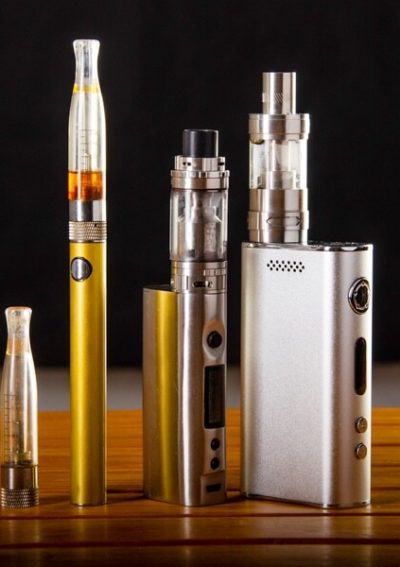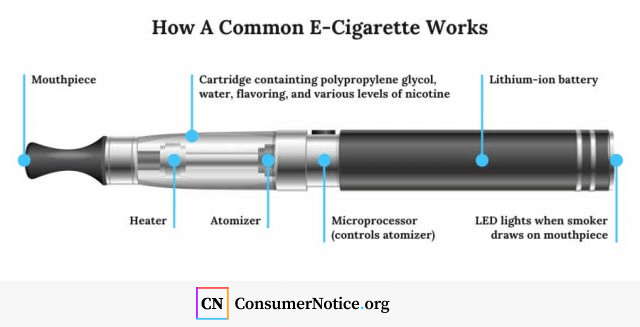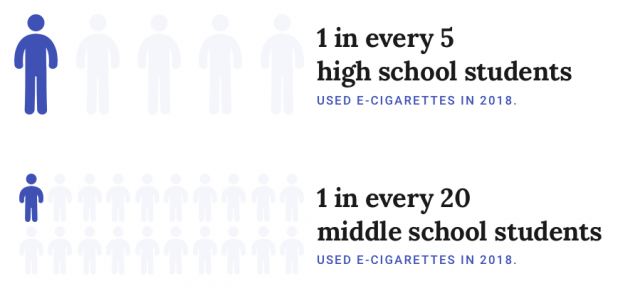E-Cigarettes
Electronic cigarettes, or e-cigarettes, hit the United States market in 2007. Since then, millions of people have taken up the tobacco alternative. But there has been little time to research the long-term health effects of the devices, and their widespread use among teens has been called an epidemic that threatens to hook a new generation on nicotine.

What Are E-Cigarettes?
E-cigarettes, also called vapes or e-cigs, are battery powered devices that heat liquids to create inhalable vapor. The U.S. Centers for Disease Control and Prevention suggests e-cigarettes may potentially help adult smokers eventually quit smoking, but more data is needed. The CDC also warns the products are not safe for teens, young adults, pregnant women or nonsmokers.
The industry faces a number of e-cigarette lawsuits, including claims related to teen nicotine addiction. According to a U.S. Food and Drug Administration and CDC study, more than 2 million middle and high school students reported using e-cigarettes in 2021. More than 80% of them used flavored e-cigarettes. Plaintiffs also claim Juul’s vaporizers exploded or caught fire, injuring users.
Juul agreed to pay $23.8 million to the city of Chicago in March 2023 to settle allegations that the company sold vaping products to underage users and deceptively marketed its products. In January 2023, Juul, the leading e-cigarette brand in the U.S., secured preliminary approval of a $255 million settlement for a class action involving economic loss claims. Plaintiffs in the class-action lawsuit said they would have paid less, or not purchased Juul’s e-cigarettes, if the company had not misrepresented its product. An estimated 200,000 to 2 million class members will receive payments.
In September 2022, Juul Labs agreed to pay $438.5 million to settle allegations from 33 states that the e-cigarette maker intentionally marketed its products to teens. In December 2022, the company also agreed to settle 10,000 claims for more than $1 billion.
How E-Cigarettes Work
E-cigarettes, or e-cigs, come in a variety of shapes and sizes. Some may look like tobacco cigarettes, pens USB drives or other objects. But most consist of a battery, heating element and a tank or compartment to hold a liquid. Liquids may come in the form of a replaceable cartridge and come in a wide variety of flavors. Using an e-cigarette is sometimes called vaping.

When the user inhales, it activates the device. The battery-powered heating element heats the liquid in the e-cig, turning it into an aerosol vapor. Users inhale this vapor into their lungs. Bystanders may also inhale it as the user exhales.
The vapor usually contains nicotine, the addictive chemical in tobacco. According to the American Lung Association, it may also contain formaldehyde and acrolein. These two chemicals are especially harmful. E-cigarettes may also be used to deliver marijuana or other illicit drugs.
E-Cigarette Myths
E-cigarettes are often marketed as smoking cessation tools or as a safe alternative to tobacco. But these and other myths about e-cigs create a smokescreen of false security about the devices.
5 Myths About E-Cigarettes
- E-Cig vapor is safe or pure
- E-cigarette vapor usually contains nicotine as well as other potentially toxic chemicals that can lead to nicotine addiction or other serious health conditions.
- E-Cigarettes are a safe alternative to tobacco
- Neither e-cigs nor the e-liquids they use are regulated for purity or safety by federal regulators. Toxins in e-liquids may not be included on labels.
- E-Cig nicotine is addictive but not dangerous
- Nicotine does not cause cancer, but it plays a key role in promoting tumor growth. It also contributes to cardiovascular and respiratory conditions.
- There is no gateway effect
- A 2017 study in the Journal of the American Medical Association Pediatrics found that young people who started with e-cigarettes were at a greater risk for moving on to tobacco use.
- E-cigs don't produce secondhand smoke
- Breathing in secondhand vapor, also called passive vaping, can expose non-users to toxic chemicals. A 2017 study in the Bulletin of the World Health Organization found that levels of some metals in secondhand vapor were higher than in secondhand smoke.
Can E-Cigarettes Help You Stop Smoking?
Manufacturers have marketed e-cigarettes as a tool to help people stop smoking. But there is no conclusive scientific evidence that e-cigs are effective at helping people quit smoking long-term, according to the National Institute on Drug Abuse.
The U.S. Food and Drug Administration has not approved e-cigarettes as a smoking cessation aid. The FDA has approved seven other quit-smoking aids that have been shown to be safe and effective. These include over-the-counter nicotine gum, lozenges and patches. It also includes two prescription drugs that do not contain nicotine, Chantix and Zyban.
The National Academies of Science, Engineering and Medicine concluded in 2018 that there is limited evidence that e-cigarettes can be effectively used to stop smoking. The academies also found insufficient evidence on whether e-cigarettes are an effective smoking cessation aid when compared to no treatment or to other FDA approved smoking cessation methods.
Many smokers who use e-cigarettes to quit do not actually completely quit cigarettes, according to the Centers for Disease Control and Prevention. Instead, they often use both.
E-Cigarette Risks
Since e-cigarettes are a relatively new invention, little is known about their long-term health effects. But a 2018 study presented at the Society for Research on Nicotine and Tobacco was the first to find evidence of long-term health risks of e-cigs. Researchers from the University of California San Francisco studied 70,000 people and found daily e-cigarette use doubled the risk of a heart attack.
Scientists already know a lot about nicotine and other chemicals the devices deliver to users. Nicotine increases a user’s heart rate and raises blood pressure and is highly addictive.
Nicotine addiction can increase the risk of cardiovascular, respiratory and digestive tract diseases. It also weakens the immune system, disturbs reproductive health and affects the health of cells in the human body, which can lead to cancer. Nicotine may also lead to Type 2 diabetes and insulin resistance.
“The more chemicals contained in an e-liquid, the more toxic it was likely to be.”
Other chemicals in e-cigarette liquids also pose serious health risks. There are more than 7,700 e-liquid flavors on the market in the United States. But the two most common chemicals are propylene glycol and vegetable glycerin. A 2018 study in PLOS Biology found that inhaling even small doses of these chemicals exposes users to high levels of toxins.
The researchers developed a system to quickly analyze the toxicity of different e-liquids. They found that flavors with more chemicals also posed greater risks to the user.
“The more chemicals contained in an e-liquid, the more toxic it was likely to be,” the authors wrote.
The researchers also set up an online database of e-liquid chemicals. E-cigarette users can search by flavor or individual chemical to find out how toxic their e-liquid is.
Fire and Explosion Risks
Unlike tobacco cigarettes, e-cigs pose an explosion risk due to their lithium ion batteries. The batteries are generally safe and are used in a multitude of electronic devices, including cell phones and computers. But the batteries can catch fire or explode when they are damaged or defective.
While explosions are rare, the Federal Emergency Management Administration highlighted the unique risk of e-cigarettes in a 2017 report.
“The combination of an electronic cigarette and a lithium-ion battery is a new and unique hazard,” the report said. “There is no analogy among consumer products to the risk of a severe, acute injury presented by an e-cigarette.”
The agency’s U.S. Fire Administration documented 195 fires and explosions associated with e-cigarettes between January 2009 and the end of 2016. These resulted in 133 injuries, including 38 that the agency classified as severe.
“The combination of an electronic cigarette and a lithium-ion battery is a new and unique hazard. There is no analogy among consumer products to the risk of a severe, acute injury presented by an e-cigarette.”
The agency found that 62% of the reported fires or explosions involving an e-cigarette or its battery happened when the device was in a pocket or in use.
The report said the design of e-cigarettes can make them “behave like ‘flaming rockets’ when a battery fails.”
Teen Vaping Risks
In addition to potential long-term health effects of e-cigarettes, teens and young adults who take up vaping are at risk of quickly developing nicotine addiction, experiencing seizures and suffering upper respiratory problems.
E-cigarettes have been the most commonly used tobacco product among young people since 2014, according to an advisory from the United States Surgeon General. And research by the National Academies of Science, Engineering and Medicine found evidence that vaping may lead teens to take up other tobacco products in the future.
A December 2018 advisory from the Surgeon General’s office labeled teen e-cig use an epidemic and noted that more than 3.6 million young Americans use the devices. The Surgeon General estimated 1 in every 5 high school students and 1 in 20 middle school students used e-cigarettes in 2018.

“The recent surge in e-cigarette use among youth, which has been fueled by new types of e-cigarettes that have recently entered the market, is a cause for great concern,” Surgeon General Jerome Adams said in the advisory.
“The recent surge in e-cigarette use among youth, which has been fueled by new types of e-cigarettes that have recently entered the market, is a cause for great concern.”
The National Academies determined that if teens or young adults take up vaping, there is “substantial evidence” they are more likely to use conventional cigarettes.
The report’s authors reviewed more than 800 different studies. They also found moderate evidence that e-cig use put young people at a higher risk for coughing and wheezing as well as asthma-related incidents.
A 2019 study in the journal Pediatrics surveyed teens and young adults and found they are unaware that they inhale nicotine when using e-cigarettes. The researchers looked at 517 adolescents who were between 12 years old and 21 years old. They found that 40% of the adolescents thought they had been using nicotine-free products but were actually inhaling the addictive chemical.
“This is one of the first studies showing the amount of nicotine kids are getting from e-cigarettes,” study author Dr. Rachel Boykan told NBC News. “They’re getting a lot — as much or more than they would with traditional cigarettes.”
Young people may also be at risk for developing seizures linked to e-cigarette use. The FDA launched an investigation into the possible connection after it received 35 reports of e-cig users experiencing seizures since 2010. The agency said most cases involved teens and young adults.
Teen Brain Risks
Nicotine in e-cigarettes can also affect brain development in teens. The human brain continues to develop into the mid-20s.
Brain cells build stronger connections, called synapses, each time a person learns a new skill or creates a new memory. Young people build these connections faster than older people. But nicotine changes the way a brain forms synapses.
Nicotine exposure during adolescence can affect memory, learning, mood, impulse control and attention. And it can increase addictive behavior, leading to abuse of other addictive substances.
Is Big Tobacco Behind E-Cigarettes?
Juul, the top-selling e-cigarette brand in the United States, marketed itself as independent of “Big Tobacco.” On June 22, 2018, the company even posted, “Juul Labs is not big tobacco” on its now-deleted Instagram account. But in December 2018, Juul sold 35% of the company’s ownership to tobacco company Altria.
Altria is the parent company of Philip Morris, the maker of Marlboro cigarettes. It controls more than half the tobacco cigarette market in the United States. As part of the deal, Altria promised to give up top-shelf display space in retail stores so that Juul e-cigs could be displayed next to Marlboro cigarettes.
Large tobacco companies have moved quickly into the e-cig business. CNBC reported that big tobacco brands had already controlled more than 20% of the e-cigarette market in the United States before the deal between Altria and Juul.
Big Tobacco E-cig and Combustible Cigarette Brands
British American Tobacco
- E-Cig Brands
- Vuse, Vype, Chic, VIP
- Tobacco Brands
- Camel, Newport, American Spirit, Lucky Strike
Imperial Brands
- E-Cig Brands
- Blu
- Tobacco Brands
- Winston, Kool, Salem, Maverick
E-cigarettes are big business, worth more than $10 billion in 2017. Sales of e-cigarettes have been increasing even as sales of conventional cigarettes have plummeted.
Some big tobacco companies prominently display their e-cigarette products on their websites and promote them to investors as products that will drive future profits.
34 Cited Research Articles
Consumernotice.org adheres to the highest ethical standards for content production and references only credible sources of information, including government reports, interviews with experts, highly regarded nonprofit organizations, peer-reviewed journals, court records and academic organizations. You can learn more about our dedication to relevance, accuracy and transparency by reading our editorial policy.
- Rajesh, A.M. (2023, March 10). Juul reaches settlement with Chicago for nearly $24 mln. Retrieved from https://www.reuters.com/legal/juul-reaches-settlement-with-chicago-nearly-24-mln-2023-03-10/
- Reuters. (2023, January 23). U.S. judge grants preliminary approval to Juul consumer settlement. Retrieved from https://www.reuters.com/business/healthcare-pharmaceuticals/juul-settlement-end-youth-vaping-lawsuits-wins-preliminary-approval-bloomberg-2023-01-20/
- Perrone, M. & Collins, D. (2022, September 6). Juul to pay nearly $440M to settle states’ teen vaping probe. Retrieved from https://apnews.com/article/science-health-lawsuits-connecticut-fce3fe4f92066a9068cf505ed1fb63b0
- Jewett, C. (2022, September 6). Juul Settles Multi-State Youth Vaping Inquiry for $438.5 Million. Retrieved from https://www.nytimes.com/2022/09/06/health/juul-settlement-vaping-crisis.html
- Centers for Disease Control and Prevention. (2022, May 5). Dual Use of Tobacco Products. Retrieved from https://www.cdc.gov/tobacco/campaign/tips/diseases/dual-tobacco-use.html
- Centers for Disease Control and Prevention. (2021, September 30). Youth E-Cigarette Use Remains Serious Public Health Concern Amid COVID-19 Pandemic. Retrieved from https://www.cdc.gov/media/releases/2021/p0930-e-cigarette.html
- Carroll, L. (2019, April 22). Vaping Teens Exposed to as Much Nicotine as Tobacco Smokers but Don’t Know It. NBC News. Retrieved from https://www.nbcnews.com/health/kids-health/vaping-teens-exposed-much-nicotine-tobacco-smokers-don-t-know-n996866
- Charles, S. (2019, April 3). FDA to Investigate Reports of Seizures Possibly Linked to E-Cigarette Use. NBC News. Retrieved from https://www.nbcnews.com/health/kids-health/fda-warns-about-possible-risk-seizures-associated-e-cigarettes-n990446
- Ho, C. (2019, April 21). Mounting Lawsuits Against Juul Reminiscent of Early Tobacco Litigation. Retrieved from https://www.sfchronicle.com/business/article/Mounting-lawsuits-against-Juul-reminiscent-of-13783089.php
- Boykan, R. et al. (2019, April). Self-Reported Use of Tobacco, E-Cigarettes and Marijuana Versus Urinary Biomarkers. Pediatrics. Retrieved from https://pediatrics.aappublications.org/content/143/5/e20183531
- U.S. Centers for Disease Control and Prevention. (2019, March 11). Quick Facts on the Risks of E-cigarettes for Kids, Teens, and Young Adults. Retrieved from https://www.cdc.gov/tobacco/basic_information/e-cigarettes/Quick-Facts-on-the-Risks-of-E-cigarettes-for-Kids-Teens-and-Young-Adults.html#one
- American Lung Association. (2019, February 22). E-Cigarettes. Retrieved from https://www.lung.org/quit-smoking/e-cigarettes-vaping/lung-health
- LaVito, A. (2018, December 20). Tobacco Giant Altria Takes 35% Stake in JUUL, Valuing E-cigarette Company at $38 Billion. CNBC. Retrieved from https://www.cnbc.com/2018/12/20/altria-takes-stake-in-juul-a-pivotal-moment-for-the-e-cigarette-maker.html
- LaVito, A. (2018, December 10). Altria Shutters Its E-cigarette Brands as it Eyes JUUL, Awaits iQOS Decision. CNBC. Retrieved from https://www.cnbc.com/2018/12/07/altria-closes-e-cigarette-brands-as-it-eyes-juul-awaits-iqos-decision.html
- U.S. Centers for Disease Control and Prevention. (2018, November 15). About Electronic Cigarettes (E-Cigarettes). Retrieved from https://www.cdc.gov/tobacco/basic_information/e-cigarettes/about-e-cigarettes.html
- Koplon, S. (2018, November 12). Vaping, E-Cigarettes, JUULing: What Parents, Teens Need to Know. University of Alabama at Birmingham. Retrieved from https://www.uab.edu/news/youcanuse/item/9937-vaping-e-cigarettes-juuling-what-parents-teens-need-to-know
- O’Connor, M. (2018, October 16). Florida Mom Sues Juul Because Her Teenage Son Can’t Stop Vaping. Miami New Times. Retrieved from https://www.miaminewtimes.com/news/florida-mom-sues-juul-because-her-teenage-son-cant-stop-vaping-10824862
- Center for Responsive Politics. (2018, September). Electronic Cigarettes. OpenSecrets.org. Retrieved from https://www.opensecrets.org/news/issues/e-cigarettes/
- Paul, D. (2018, July 30). E-Cigarette Maker Juul Targeted Teens With False Claims of Safety, Lawsuit Says. Retrieved from https://www.washingtonpost.com/news/to-your-health/wp/2018/07/30/e-cigarette-maker-juul-targeted-teens-with-false-claims-of-safety-lawsuit-claims/
- Brazier, Y. (2018, June 25). Are E-Cigarettes a Safe Alternative to Smoking? Medical News Today. Retrieved from https://www.medicalnewstoday.com/articles/216550
- Glantz, S.A. (2018, February 24). First Evidence of Long-Term Health Damage from E-Cigs: Smoking E-Cigarettes Daily Doubles Risk of Heart Attacks. Retrieved from https://tobacco.ucsf.edu/first-evidence-long-term-health-damage-ecigs-smoking-e-cigarettes-daily-doubles-risk-heart-attacks
- Sassano, M.F. et al. (2018, March 27). Evaluation of E-Liquid Toxicity Using an Open-Source High-Throughput Screening Assay. (PloS Biology). Retrieved from https://www.ncbi.nlm.nih.gov/pubmed/29584716
- The National Academies of Sciences, Engineering and Medicine. (2018, January). Public Health Consequences of E-Cigarettes. Retrieved from https://www.nap.edu/resource/24952/012318ecigaretteConclusionsbyEvidence.pdf
- Adams, J. (2018). Surgeon General’s Advisory on E-Cigarette Use Among Youth. U.S. Surgeon General. Retrieved from https://e-cigarettes.surgeongeneral.gov/documents/surgeon-generals-advisory-on-e-cigarette-use-among-youth-2018.pdf
- U.S. Food and Drug Administration. (2017, December 12). Want to Quit Smoking? FDA-Approved Products Can Help. Retrieved from https://www.fda.gov/consumers/consumer-updates/want-quit-smoking-fda-approved-products-can-help
- Soneji, S. et al. (2017, August 1). Association Between Initial Use of e-Cigarettes and Subsequent Cigarette Smoking Among Adolescents and Young Adults: A Systematic Review and Meta-analysis. JAMA Pediatrics. Retrieved from https://pubmed.ncbi.nlm.nih.gov/28654986/
- U.S. Fire Administration. (2017, July). Electronic Cigarette Fires and Explosions in the United States, 2009-2016. Federal Emergency Management Administration. Retrieved from https://www.usfa.fema.gov/downloads/pdf/publications/electronic_cigarettes.pdf
- Wilson, N. et al. (2017, April 28). Should E-Cigarette Use Be Included in Indoor Smoking Bans? Bulletin of the World Health Organization. Retrieved from https://www.ncbi.nlm.nih.gov/pmc/articles/PMC5487972/
- British American Tobacco. (n.d.). Overview of Our Portfolio. Retrieved from https://www.bat.com/brands
- Center for Tobacco Regulatory Science and Lung Health. (n.d.). Welcome to the E-Liquid Database. Retrieved from https://eliquidinfo.org/
- Imperial Brands. (n.d.). ITG Brands. Retrieved from https://www.imperialbrandsplc.com/About-us/Our-companies/ITG-Brands.html
- Johns Hopkins Medicine. (n.d.). 5 Truths You Need to Know About Vaping. Retrieved from https://www.hopkinsmedicine.org/health/wellness-and-prevention/5-truths-you-need-to-know-about-vaping
- PhilipMorrisUSA. (n.d.). Our Products & Ingredients. Retrieved from https://www.philipmorrisusa.com/products/our-products-and-ingredients
- SmokeFree.gov. (n.d.). What We Know About Electronic Cigarettes. Retrieved from https://smokefree.gov/quit-smoking/ecigs-menthol-dip/ecigs
Calling this number connects you with a Consumer Notice, LLC representative. We will direct you to one of our trusted legal partners for a free case review.
Consumer Notice, LLC's trusted legal partners support the organization's mission to keep people safe from dangerous drugs and medical devices. For more information, visit our partners page.
844-420-1914


